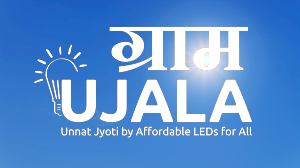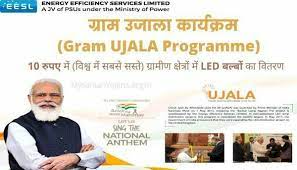GRAM UJALA Scheme

Introduction
In India, electricity is a crucial commodity for households and businesses alike. Despite progress made in the sector over the years, many rural areas still lack access to electricity. To address this issue, the Indian government has launched various schemes, one of which is the GRAM UJALA scheme. This article will explore the details of the GRAM UJALA scheme, its benefits, and how it is helping to electrify rural India.
What is the GRAM UJALA Scheme?
The GRAM UJALA scheme is an initiative launched by the Indian government in 2015 to provide affordable LED bulbs to rural households. The scheme is part of the government’s efforts to promote energy efficiency, reduce energy consumption, and reduce carbon emissions. READ ALSO-PM UMEED SCHEME
How does the GRAM UJALA Scheme work?
Under the GRAM UJALA scheme, the government provides LED bulbs to rural households at subsidized rates. The bulbs are sold through designated distribution centers at a cost of Rs 10 per bulb. This price is significantly lower than the market price, which ranges from Rs 150 to Rs 300 per bulb.
Benefits of the GRAM UJALA Scheme

The GRAM UJALA scheme has several benefits, including:
Cost Savings
LED bulbs are significantly more energy-efficient than traditional incandescent bulbs. This means that households that switch to LED bulbs can save a significant amount of money on their electricity bills.
Environmental Benefits
LED bulbs use less energy and have a longer lifespan than traditional bulbs. This means that they produce less carbon emissions and reduce the amount of waste generated by disposing of burnt-out bulbs.
Improved Lighting
LED bulbs provide brighter and more consistent lighting than traditional bulbs. This makes it easier for households to carry out daily activities such as cooking, reading, and studying.
Impact of the GRAM UJALA Scheme
Since its launch, the GRAM UJALA scheme has had a significant impact on rural India. According to government estimates, the scheme has distributed over 36 crore LED bulbs to rural households, resulting in energy savings of over 47 billion units. This has translated into cost savings of over Rs. 19,000 crore for households.
In addition, the scheme has also had a positive impact on the environment. The energy savings resulting from the use of LED bulbs have reduced carbon emissions by over 38 million tonnes.
Challenges faced by the GRAM UJALA Scheme

Despite its success, the GRAM UJALA scheme has faced several challenges. One of the main challenges is the lack of awareness among rural households about the benefits of LED bulbs. Many households are still using traditional bulbs, unaware of the cost and energy savings that can be achieved by switching to LED bulbs.
Another challenge is the lack of availability of LED bulbs in remote areas. The distribution centers are mostly located in urban areas, making it difficult for households in remote areas to access them.
Conclusion
The GRAM UJALA scheme is an important initiative aimed at promoting energy efficiency and providing affordable lighting solutions to rural households in India. The scheme has had a significant impact on rural India, resulting in cost savings for households and reducing carbon emissions.
However, there is still a need to create more awareness about the benefits of LED bulbs and ensure that they are available to households in remote areas.
FAQs
What is the cost of an LED bulb under the GRAM UJALA scheme?
Ans: The cost of an LED bulb under the GRAM UJALA scheme is Rs 10.
How has the GRAM UJALA scheme impacted rural India?
Ans: The GRAM UJALA scheme has distributed over 36 crore LED bulbs to rural households, resulting in energy savings of over 47 billion units and cost.
How has the GRAM UJALA scheme impacted rural India?
Ans: The GRAM UJALA scheme has distributed over 36 crore LED bulbs to rural households, resulting in energy savings of over 47 billion units and cost savings of over Rs 19,000 crore.
What are the environmental benefits of using LED bulbs?
Ans: LED bulbs use less energy and have a longer lifespan than traditional bulbs, which reduces carbon emissions and waste.
Are LED bulbs easily available in remote areas?
Ans: Distribution centers for LED bulbs are mostly located in urban areas, which makes it difficult for households in remote areas to access them.
What is the aim of the GRAM UJALA scheme?
Ans: The aim of the GRAM UJALA scheme is to promote energy efficiency and provide affordable lighting solutions to rural households in India.
1 thought on “GRAM UJALA Scheme”